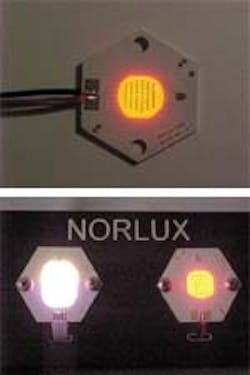
The notion of using light-emitting diodes (LEDs) for general room illumination is becoming less far-fetched as time goes by. Boosting the electrical-to-optical efficiency of LEDs is one way to hasten their everyday use; lowering their cost is another. A third, less obvious, approach is to improve the devices' packaging. Engineers at NorLux Corp., a division of Uniroyal Technology Corp. (Sarasota, FL) have developed an LED array that, rather than holding traditional LEDs consisting of one encapsulated chip per emitter (usually bullet-shaped), contains a closely spaced array of chips mounted to an aluminum substrate (top). Such a configuration yields high light emission over a small area, efficient heat sinking, and easy mounting.
In a typical monochrome device, 40 LED chips are packed within a 10-mm diameter and the entire area sealed with an epoxylike overcoat. A white-light emitter contains 90 chips (bottom). Two white-light versions have been developed: an amber-blue combination that approximates white at low cost, and a red-blue-green combination for higher-quality white. The LED chips themselves are separated from the aluminum by a dielectric layer that is thermally but not electrically conductive, explains Andy Lipman, vice president and general manager of NorLux. The aluminum draws heat from the chips, allowing the device to be driven at higher levels than standard LEDs.
In development are improved electromechanical connections and snap-on optics. Such optics will increase on-axis intensity by an order of magnitude or more. One example is a total-internal-reflection lens that accepts 180° of incoming radiation and produces a 30° outgoing cone of light, says Lipman. In addition to general lighting, uses for the NorLux device will include illumination for machine vision, signs, aviation, and transportation, including traffic lights.
About the Author
John Wallace
Senior Technical Editor (1998-2022)
John Wallace was with Laser Focus World for nearly 25 years, retiring in late June 2022. He obtained a bachelor's degree in mechanical engineering and physics at Rutgers University and a master's in optical engineering at the University of Rochester. Before becoming an editor, John worked as an engineer at RCA, Exxon, Eastman Kodak, and GCA Corporation.
